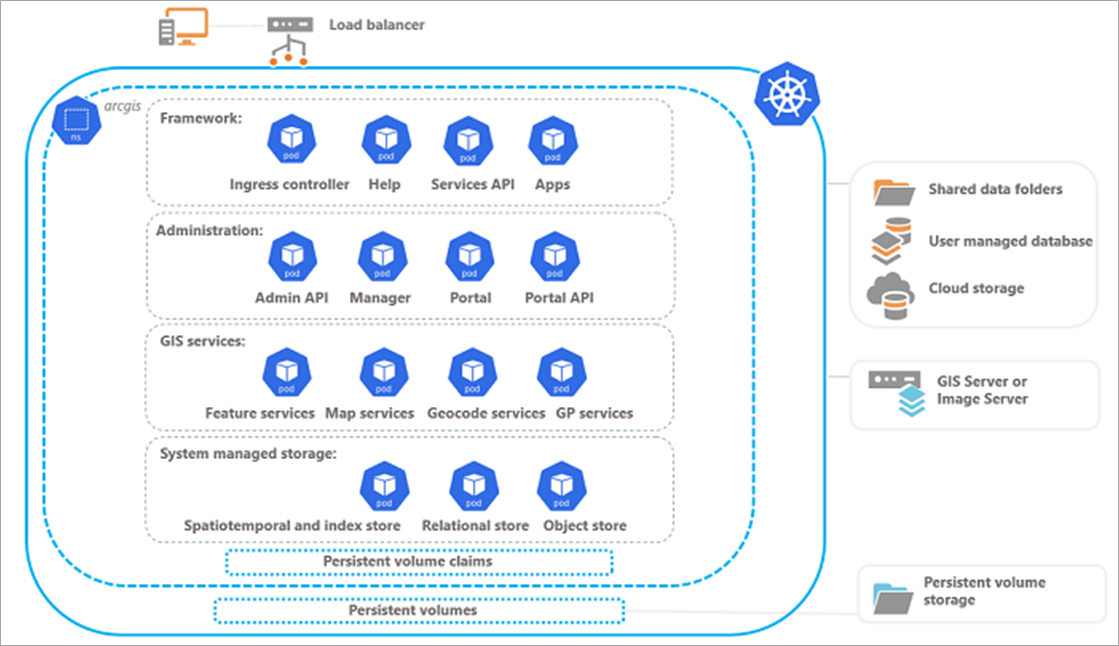AWS Partner Network (APN) Blog
Leveraging the Power of Esri’s ArcGIS Enterprise on Kubernetes Through Amazon EKS
By Trevor Seaton, Principal Product Manager – Esri
By Wally Gallaway, Principal, Global ISV Sales – AWS
By Damion Harrylal, Sr. Solutions Architect, WWPS – AWS
By Sid Singh, Principal Tech BD – AWS
 |
| Esri |
 |
Esri‘s geographic information system (GIS) solutions create, manage, analyze, and map various types of geospatial data. Its flagship GIS mapping software, ArcGIS, is a powerful mapping and spatial analytics technology.
Amazon Web Services (AWS) and Esri have had a long-standing collaboration focused on bringing innovation through the powerful combination of GIS and AWS.
Esri is an AWS Partner and AWS Marketplace Seller with the AWS Public Safety Competency. Inspiring positive change in industry and society through mapping and geospatial analytics is at the heart of its business, as Esri provides GIS solutions to more than 350,000 clients in 150+ countries.
In this post, we will take a look at the deployment of ArcGIS Enterprise on Amazon Elastic Kubernetes Service (Amazon EKS).
Collaborating with Esri to Build Solutions
Working together, AWS and Esri have enhanced ArcGIS Enterprise to help customers put the power of ArcGIS into their own environments, which can be configured for high availability and to scale to increasing levels of demand.
Larger mission-critical deployments traditionally tend to increase complexity and corresponding operational support requirements. With the new Kubernetes architecture for ArcGIS Enterprise, such deployments are easier to deploy, configure, and manage.
This new Kubernetes architecture further enhances the product’s scalability and resilience. It also improves manageability by reducing technical complexity, leveraging a fully cloud-native architecture that can scale to the rapidly growing demand for GIS services today.
ArcGIS Enterprise on Kubernetes launched in 2021 and is fully supported and ready for production workflows by Esri and AWS Cloud customers. It includes functionality corresponding to a base deployment of ArcGIS Enterprise, with the advantages of a cloud-native architecture. The advantages are speed to deployment coupled with scalability and high levels of availability.
“As we built and launched this new cloud-native architecture, partnering with the AWS team has been an important aspect of our development efforts,” said Jay Theodore, Chief Technology Officer for ArcGIS Enterprise at Esri. “From applying patterns of microservices and containerization to rethinking, innovating, and validating ArcGIS Enterprise working with AWS compute and storage services, this collaboration has been crucial.”
To support a seamless customer experience for production deployments, Esri Product Development leverages the AWS infrastructure for development and test.
“This has helped us ensure that Esri customers that use AWS services experience a resilient, scalable, and manageable deployment option for ArcGIS Enterprise, in addition to all the functionality they have come to expect from a modern geospatial cloud-based system,” said Theodore.
Esri on AWS Services
ArcGIS Enterprise on Kubernetes runs as microservices across a Kubernetes cluster, providing the scaling and tuning benefits of cloud-native delivered as container images, which simplify and accelerate deployments and upgrades.
When deploying on AWS, it uses Amazon EKS as the managed Kubernetes service, accessing co-located data to help ensure AWS customers experience the most advanced geospatial cloud.
This co-located data includes those in Amazon Simple Storage Service (Amazon S3), Amazon Aurora, Amazon Relational Database Service (Amazon RDS), and Amazon Redshift.
For an overview of supported cluster providers on which ArcGIS Enterprise is supported, see the system requirements.
Solution Architecture
The ArcGIS Enterprise on Kubernetes architecture is showcased below. The diagram illustrates a Kubernetes cluster containing a namespace called arcgis, which contains four categories of pods that represent various system functions.
The diagram does not represent a complete list of pods or requirements, but rather depicts an overview of how the system is organized.
For more information about system requirements, deploying, planning and preparing, visit the Kubernetes system architecture.
Figure 1 – ArcGIS deployment on EKS.
Conclusion
AWS and Esri have worked closely together to advance cloud-native architecture. ArcGIS Enterprise on Kubernetes is fully supported and ready-for-production workflows by Esri’s and AWS customers.
For more information, speak with your AWS or Esri representative and visit ArcGIS Enterprise on Kubernetes.
Esri – AWS Partner Spotlight
Esri is an AWS Partner that is inspiring positive change in industry and society through mapping and geospatial analytics is at the heart of its business. Esri provides GIS solutions to more than 350,000 clients in 150+ countries.
Contact Esri | Partner Overview | AWS Marketplace | Case Studies

